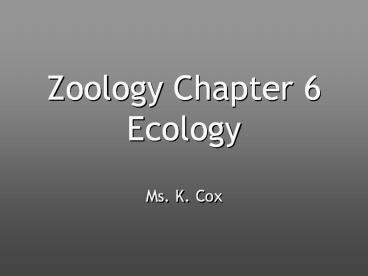Zoology Chapter 6 Ecology - PowerPoint PPT Presentation
Title:
Zoology Chapter 6 Ecology
Description:
Zoology Chapter 6 Ecology Ms. K. Cox Introduction Ecology is the study of organisms and their relationships to each other, as well as the components of their environment. – PowerPoint PPT presentation
Number of Views:1448
Avg rating:3.0/5.0
Title: Zoology Chapter 6 Ecology
1
Zoology Chapter 6Ecology
- Ms. K. Cox
2
Introduction
- Ecology is the study of organisms and their
relationships to each other, as well as the
components of their environment. The habitat of
an organism includes all biotic and abiotic
characteristics of the area that it inhabits.
3
Energy
- Organisms gain and use energy in different ways.
There are two main energy sources - autotrophs are typically photosynthetic
- heterotrophs eat autotrophs or other heterotrophs.
4
How is Energy Used
- The energy budgets of organisms also vary
- Habitat ranges and metabolic rates are different
for endotherms and ectotherms. - Torpor, hibernation, and winter sleep may act to
conserve energy during colder periods. - Aestivation occurs during periods of heat and
drying.
5
- A population is a group of organisms of one
species that occupy the same area at a given
time. Population size is influenced by birth and
death rates and dispersal rates. Survivorship
curves illustrate mortality patterns as a
function of age there are 3 main types of
survivorship curves pg 82
6
Logistic population growth
- . Populations with abundant resources may exhibit
exponential growth for a period, but they
typically reach a carrying capacity, the maximum
population size that can be supported
indefinitely.
7
Interactions between different populations
structure the community
- herbivores include animals that eat plant parts
- predators feed on other organisms, so predator
and their prey populations are intricately tied
together.
8
Interactions between different populations
structure the community
- Another form of interaction between populations
is interspecific competition it may result in
competitive exclusion, the local extinction of
one species, or coexistence.
9
Interactions
- In coevolution, the two species evolve in
response to each other, as illustrated by insects
and the plants they pollinate. - In symbiosis, an intimate relationship develops
between two different species coevolution is
also common among symbionts. Symbiosis includes
parasitism, commensalisms, and mutalism.
10
Interactions
- In parasitism, one organism lives in or on
another organism, called the host. The
definitive host is the host that harbors the
sexually reproductive stage of the parasite. - Commensalisms is a relationship in which one
organism benefits and the other is neither harmed
nor helped. - In mutualism, both species benefit by their
symbiosis.
11
Interactions
- Camouflage occurs when body color patterns are
used to hide the animal cryptic coloration that
is a type of camouflage that occurs when the
animal blends in with the environment. - Countershading occurs when animals are dark on
top, but light on the bottom and therefore less
visible to predators looking upward to see them. - Aposematic coloration is a warning coloration.
- Mimicry occurs when a prey species resembles
another inedible or distasteful species.
12
Energy Flow
- An ecosystem is composed of both communities and
the environment in which they live. - Ecosystems may be best understood by analyzing
energy transfers with them. The passage of
energy through the populations of organisms may
be depicted as a food chain, or more
realistically as a food web. The food web has 3
main trophic levels
13
Three main trophic levels
- 1. Producers are typically autotrophs
(photosynthetic plants). - 2. Consumers may be described as herbivores,
carnivores, or scavengers. - 3. Decomposers clean up left over plant
material, dead organisms, and excrement. - The efficiency of energy transfers across trophic
levels varies from lt1 for herbivorous endotherms
to 35 for carnivorous ectotherms.
14
Humans
- Global human population may have already exceeded
the carrying capacity of our planet, but carrying
capacity depends on the standard of living for
all people and on the way in which resources are
distributed































